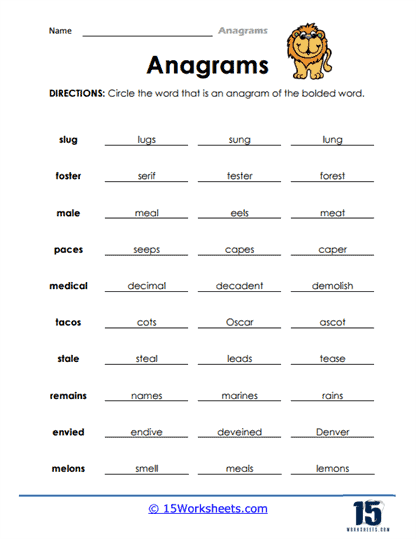
Unlocking Word Potential: The Enduring Power of Anagrams Worksheets
In the vast landscape of language learning and cognitive development, few tools combine the simplicity of a puzzle with the profound impact on mental acuity quite like anagrams. These clever wordplay challenges, where letters of a word or phrase are rearranged to form a new one, have captivated minds for centuries. But in the modern educational and recreational context, it is the structured and accessible format of anagrams worksheets that truly shines, offering a versatile pathway to enhanced vocabulary, improved spelling, and sharper critical thinking skills.
This comprehensive article will delve into the multifaceted world of anagrams worksheets, exploring their fundamental nature, the extensive benefits they offer across various age groups and learning environments, practical guidance on creating them, and innovative ways to integrate them into daily routines for maximum impact.
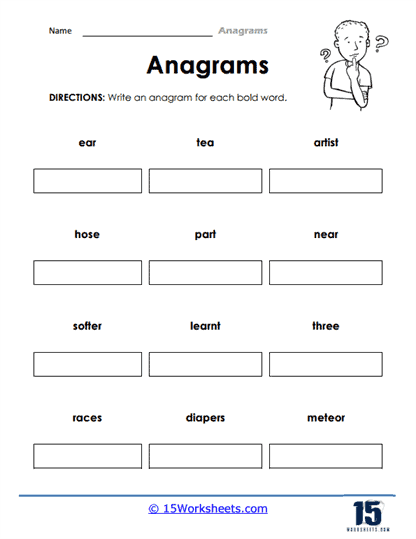
What Exactly Are Anagrams Worksheets?

At its core, an anagrams worksheet is a carefully designed activity sheet presenting a list of jumbled letters, often forming a single word, that participants must rearrange to discover the original or a new, meaningful word. These sheets typically include:
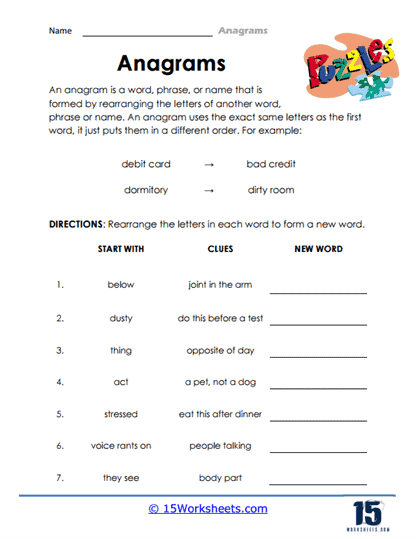
- Scrambled Words: A column or list of letter sequences that are anagrams of specific words.
- Blank Spaces: Corresponding blank lines or boxes where the unscrambled word should be written.
- Hints (Optional): Sometimes, a clue such as the definition of the word, its category, or the number of letters in the solution is provided to aid the solver.
- Answer Key: Essential for self-correction and for facilitators to quickly check responses.
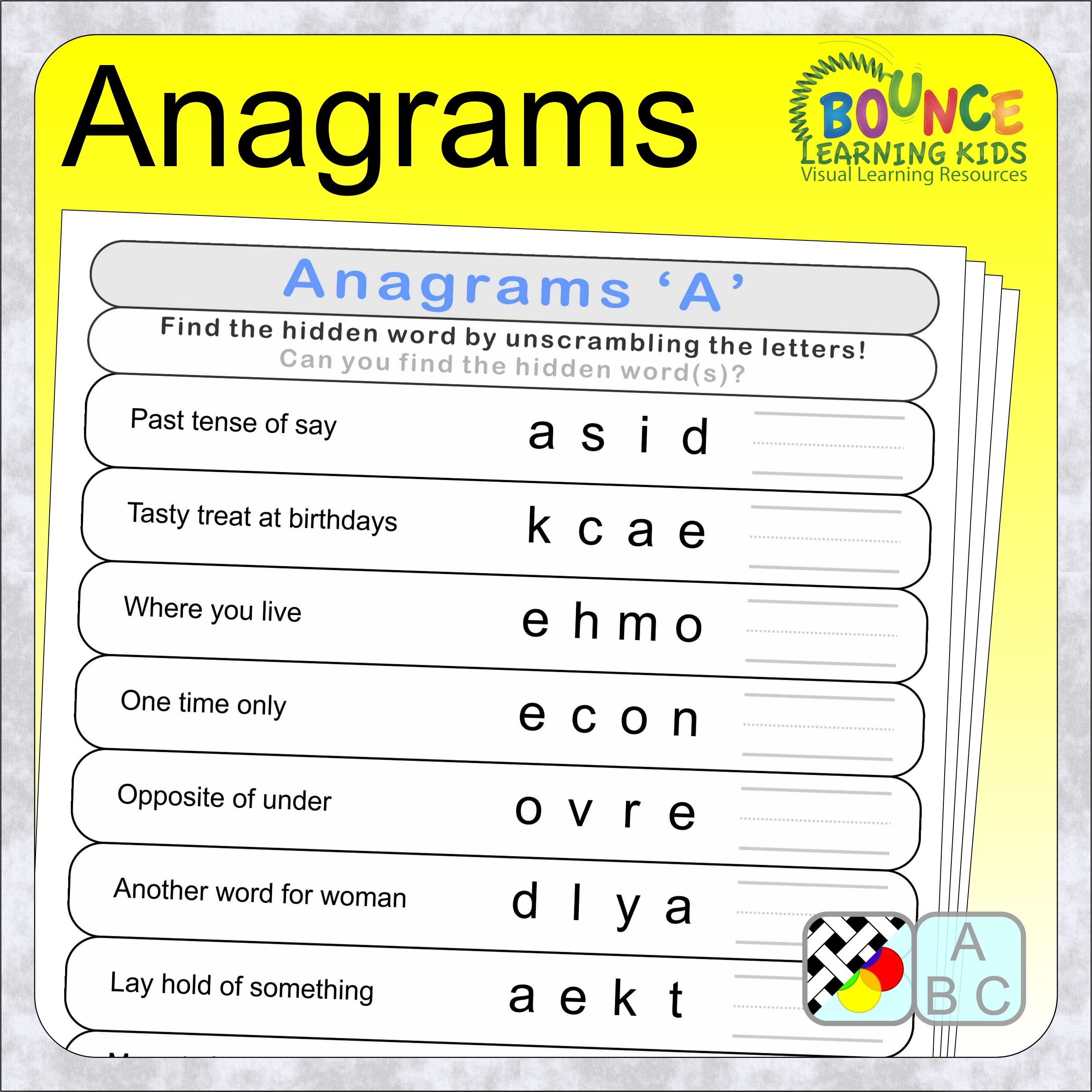
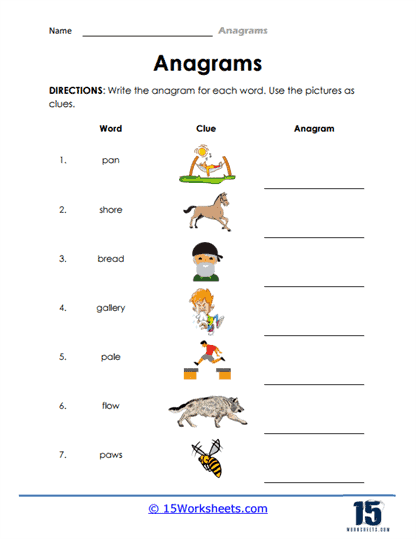
While the concept is straightforward, the complexity and thematic focus of anagrams worksheets can vary wildly, making them suitable for everyone from young children just beginning their reading journey to adults seeking to keep their minds sharp.
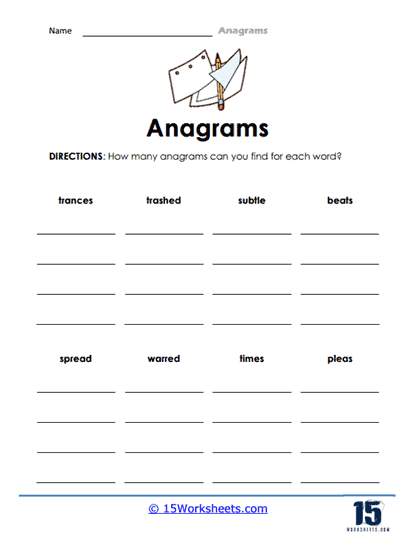
The Multifaceted Benefits of Engaging with Anagrams Worksheets
The appeal of anagrams worksheets extends far beyond mere entertainment. Their regular use fosters a rich array of cognitive and linguistic advantages:
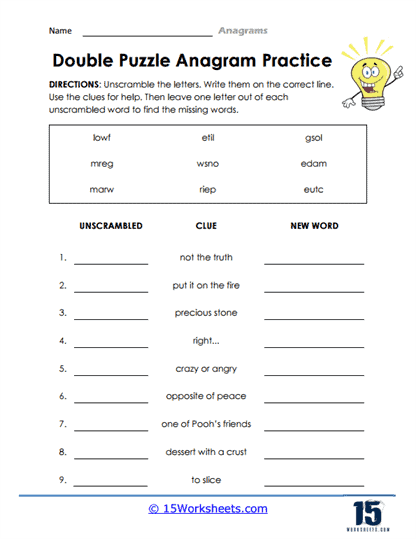
-

Enhances Vocabulary: As users unscramble words, they often encounter new terms or reinforce their understanding of existing ones. This active recall and manipulation of letters help cement words in memory, making them a powerful tool for vocabulary expansion. For learners of all ages, especially those acquiring English as a second language (ESL/EFL), anagrams provide a practical, hands-on method to internalize new words and their spellings.
-
Improves Spelling and Phonics: To successfully solve an anagram, one must pay close attention to the individual letters within a word and their correct sequence. This meticulous focus naturally strengthens spelling skills and reinforces phonemic awareness – the understanding of how sounds relate to letters. The act of physically rearranging letters (even mentally) helps solidify the visual representation of words.
-
Boosts Problem-Solving and Critical Thinking: Anagrams are essentially linguistic puzzles. Solving them requires a systematic approach, trial and error, pattern recognition, and logical deduction. Participants must analyze the given letters, hypothesize possible combinations, and test their theories against their knowledge of words. This process hones vital problem-solving abilities that are transferable to many other areas of life.
-
Develops Pattern Recognition: Over time, consistent engagement with anagrams helps individuals recognize common letter patterns, prefixes, suffixes, and root words more quickly. This intuition speeds up the unscrambling process and improves overall word recognition skills.
-
Strengthens Memory and Recall: The effort to retrieve the correct word from a jumbled set of letters acts as a powerful memory exercise. It engages both short-term memory (holding the scrambled letters) and long-term memory (accessing the lexicon of known words).
-
Fosters Concentration and Focus: Anagrams demand sustained attention. To crack a challenging anagram, distractions must be tuned out, and the solver must remain focused on the task at hand. This builds mental stamina and the ability to concentrate for extended periods.
-
Stimulates Creativity and Divergent Thinking: While many anagrams have a single correct answer, some letter combinations can form multiple words. This encourages flexible thinking and the exploration of various possibilities, fostering a degree of linguistic creativity.
-
Reduces Stress and Provides Mental Stimulation: For many, the engaging nature of word puzzles can be a relaxing yet mentally stimulating activity. It offers a constructive way to pass time, serving as a brain workout that feels more like play than work.
-
Promotes Engagement and Fun in Learning: Traditional rote memorization can be tedious. Anagrams worksheets introduce a gamified element to learning, making the process of acquiring new words and sharpening skills enjoyable and interactive. This increased engagement often leads to better retention.

Creating Your Own Anagrams Worksheets: A Step-by-Step Guide
While a plethora of pre-made anagrams worksheets are available online, there’s immense value in creating your own, especially if you want to tailor them to specific themes, vocabulary lists, or difficulty levels.
-
Choose Your Words:
- Theme: Select a theme relevant to your learning objective or interest (e.g., "Animals," "Food," "Science Terms," "Holiday Vocabulary"). This makes the worksheet more engaging and helps reinforce related concepts.
- Difficulty: For beginners, start with 3-5 letter words. Gradually increase the length and complexity as skills improve. Consider using words with unique letter combinations (e.g., "rhythm" vs. "apple").
- Vocabulary List: If you’re targeting specific words, list them out.
-
Scramble the Letters:
- Manually: For each chosen word, rearrange its letters. Ensure the scrambled version doesn’t accidentally form another common word (unless that’s your intention for an advanced challenge). For example, "EARTH" could become "HEART" – this might be too easy a clue for "EARTH." Scrambling "LISTEN" to "SILENT" is a classic example of an anagram that forms another word.
- Online Anagram Generators: Numerous websites offer free anagram generators. Simply type in your word, and it will provide various scrambled versions. This is efficient for creating many items quickly.
-
Format Your Worksheet:
- Clear Give your worksheet an engaging title (e.g., "Unscramble the Animals!").
- Instructions: Provide concise instructions (e.g., "Unscramble the letters to form a word. Write your answer on the line provided.").
- Layout: Create two columns: one for the scrambled words and one for the blank lines. Number each item.
- Hints (Optional): If desired, add a hint next to each scrambled word, such as its definition, a sentence using the word, or its category.
- Answer Key: Crucially, create a separate answer key. This saves time during correction and allows for self-assessment.
-
Test and Refine: Before printing or distributing, try solving the worksheet yourself or have someone else test it. This helps catch any errors, ensure clarity, and gauge the appropriate difficulty level.
Types of Anagrams Worksheets for Diverse Learning Needs
The adaptability of anagrams allows for a wide variety of worksheet types, catering to different ages, skill levels, and learning objectives:
- Basic Word Anagrams: The most common type, where single words are scrambled. Ideal for vocabulary building and spelling practice.
- Themed Anagrams: Worksheets focused on a specific topic (e.g., "Christmas Anagrams," "Science Lab Anagrams," "US States Anagrams"). These are excellent for reinforcing subject-specific vocabulary.
- Definition-Based Anagrams: Participants are given a definition, and they must unscramble the letters to find the word that matches the definition. This adds an extra layer of challenge and reinforces meaning.
- Sentence Anagrams (Scrambled Sentences): More advanced, where an entire sentence has its words jumbled. The task is to rearrange the words to form a grammatically correct and meaningful sentence. This targets syntax and sentence structure.
- Crossword Anagrams: A hybrid where anagrams are the clues for a crossword puzzle. Solvers must first unscramble the word and then fit it into the grid.
- Picture-Based Anagrams: For younger learners, pictures can accompany the scrambled letters, providing a visual clue to the word.
- Competitive Anagrams: Timed challenges or team-based competitions using anagrams worksheets can add an exciting, high-energy element to learning.
Integrating Anagrams Worksheets into Educational and Recreational Settings
The utility of anagrams worksheets extends across numerous environments:
- Classrooms: Teachers can use them as warm-up activities, vocabulary reviews, spelling tests, or as part of a literacy center. They are also excellent for differentiating instruction, offering varied difficulty levels for diverse learners.
- Homeschooling: Parents can integrate them into daily lessons as a fun, educational break or as a supplementary tool for specific subjects.
- Therapeutic Settings: Speech therapists and occupational therapists use anagrams to help patients with cognitive rehabilitation, memory enhancement, and language development.
- Adult Learning and Brain Training: For adults, anagrams provide a stimulating way to maintain cognitive agility, improve mental flexibility, and simply enjoy a challenging puzzle during leisure time.
- ESL/EFL Instruction: As mentioned, anagrams are invaluable for non-native English speakers to internalize spelling, pronunciation patterns, and word structures.
Maximizing Engagement: Tips for Users and Facilitators
To get the most out of anagrams worksheets, consider these tips:
- Start Simple, Progress Gradually: Begin with easier words and shorter lists to build confidence, then gradually introduce more complex challenges.
- Encourage Collaboration: For group settings, allow students to work in pairs or small teams. This fosters peer learning and problem-solving.
- Use Timers (Optional): For a competitive edge or to encourage speed, set a timer. However, for learners who struggle, allow ample time without pressure.
- Provide Hints Strategically: If a solver is stuck, offer a gentle hint, such as the first letter of the word, its definition, or its category, rather than giving the answer outright.
- Celebrate Success: Acknowledge and praise efforts, regardless of whether all anagrams were solved. The process of thinking and trying is what matters.
- Make it Themed and Relevant: Connecting anagrams to current events, holidays, or classroom topics significantly boosts engagement.
- Vary the Format: Don’t stick to the same layout. Experiment with different types of anagrams worksheets to keep things fresh.
Beyond the Worksheet: Extending the Anagram Fun
While worksheets provide a structured framework, the spirit of anagrams can be extended into various games and activities:
- Anagram Challenges: A daily "Anagram of the Day" on a whiteboard.
- Team Competitions: Two teams race to solve anagrams.
- Creative Writing: Challenge participants to create their own anagrams from a given word list.
- Word Games: Many popular board games and mobile apps are built around anagram principles.
Conclusion
In an increasingly digital world, the humble anagrams worksheet stands as a testament to the enduring power of simple, yet effective, educational tools. From boosting vocabulary and spelling to sharpening critical thinking and problem-solving skills, their benefits are profound and far-reaching. Whether used in a bustling classroom, a quiet homeschooling environment, or simply as a leisure activity for a curious mind, anagrams worksheets offer an accessible, engaging, and highly effective way to unlock the vast potential hidden within the letters of our language. They transform the act of learning into a delightful puzzle, proving that sometimes, the most powerful educational experiences are also the most fun.
